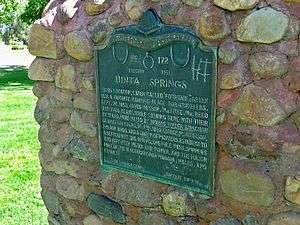Fountain Green massacre

The Fountain Green massacre is one of the more frequently cited examples of violence between Utes and Mormon colonists surrounding the so-called Walker War. A Daughters of the Utah Pioneers monument (no. 172), located in City Park in Fountain Green, UT, memorializes the Fountain Green Massacre.
Event
In the early morning hours of October 1, 1853, Utes of Sanpitch attacked and killed four men—William Reed, James Nelson, William Luke, and Thomas Clark—who were encamped at Uinta Springs, near the head of Salt Creek Canyon. The men were driving two ox-drawn wagons filled with wheat to Salt Lake City, as the advance party of a larger group headed by local Manti, UT Mormon leader Isaac Morley. William Luke, an immigrant from Manchester, England, was anxious to go see his three sons, who had recently arrived from England, and may have encouraged the group to hasten its journey. The four men camped at Uinta Springs against Morley's instructions, which had been for the group to make camp on the San Pitch River and await the arrival of the main group.
When Morley's group arrived at the camp, they found William Reed stripped, scalped, and disemboweled a short distance from the wagons. Luke and Nelson's throats were cut; they were also disemboweled. The Morley party emptied the wagons of their grain and then loaded three of the bodies for transport to Nephi, Utah (Clark's body later being found by a relative) and as the party readied to move on, numerous Utes appeared on the hillside. Oral tradition holds that Morley, angry over disobedience to his orders, denied the dead men burial in the town cemetery. Their gravesites are unknown, despite efforts to locate the remains of the four men.[1]
Revenge
Soon after the massacre, eight Utes were murdered in Nephi, in an act of revenge.[2] According to a prominent local woman:
This barbarous circumstance actuated our brethren, counseled by Father Morley of San Pete…and President Call of Filmore, to do quite as barbarous an act the following morning, being the Sabbath. Nine Indians coming into our Camp looking for protection and bread with us, because we promised it to them and without knowing they did the first evil act in that affair or any other, were shot down without one minute's notice. I felt satisfied in my own mind that if Mr. Heywood had been here they would not have been dealt with so unhumanly. It cast considerable gloom over my mind.— Martha Spence Heywood, Journal
In 2006[3] the remains of the slain Utes were discovered in an area of Nephi called Old Hallow.[4]
Subsequent violence
A little less than five years later, four Danish immigrants--Jens Jorgensen, his wife Hedevig Jorgensen[5] Jens Terklesen, and Christian I. Kjerulf--were slain by natives in Salt Creek Canyon, while they were en route to settle with other Scandinavian immigrants in the Sanpete Valley. This tragedy, known as the Salt Creek Canyon Massacre, was marked by the brutality with which Jorgensen's wife and unborn child were butchered with a tomahawk.
References
- ↑ Trauntvein, Myrna. "Digging for Relatives (Ancestors dig for skeletal remains near Nephi City Cemetery)". The Times=News. Nephi, UT.
- ↑ Carter, D. Robert (April 12, 2008). "Early settlements in Central Utah (Frontier violence traumatized both colonists and Indians)". Daily Herald.
- ↑ Trauntvein, Myrna (August 9, 2006). "Skeletal remains found at construction site in Nephi". The Times-News. Nephi, Utah. Retrieved August 17, 2016.
- ↑ Trauntvein, Myrna (June 27, 2007). "Native American remains reveal evidence of being executed". nephitimesnews.com. The Times-News (Nephi). Retrieved August 17, 2016.
- ↑ Rodney Sorensen. "Killed by the Indians". Sorensen Family History. Retrieved August 17, 2013.
Sources
- Bigler, David L. (1998). Forgotten Kingdom: The Mormon Theocracy in the American West, 1847-1896. Arthur H. Clark Company. ISBN 978-0-87062-282-3.
- Gottfredson, Peter (1919). History of Indian Depredations in Utah. Skelton Publishing Company. OCLC 2326617.
- Michno, Gregory & Susan (2008). Forgotten Fights: Little Known Raids and Skirmishes on the Frontier, 1823 to 1890. Mountain Press Publishing Company. ISBN 978-0-87842-549-5.
- Whitney, Orson F. (1892). History of Utah. George Q. Cannon & Sons. OCLC 504189185.
See also
- Latter Day Saint martyrs
- List of massacres in Missouri
- Missouri Executive Order 44
- Salt Creek Canyon massacre
- Utah War